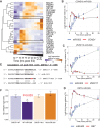An integrative transcriptomics approach identifies miR-503 as a candidate master regulator of the estrogen response in MCF-7 breast cancer cells
- PMID: 27539783
- PMCID: PMC5029456
- DOI: 10.1261/rna.056895.116
An integrative transcriptomics approach identifies miR-503 as a candidate master regulator of the estrogen response in MCF-7 breast cancer cells
Abstract
Estrogen receptor α (ERα) is an important biomarker of breast cancer severity and a common therapeutic target. In response to estrogen, ERα stimulates a dynamic transcriptional program including both coding and noncoding RNAs. We generate a fine-scale map of expression dynamics by performing a temporal profiling of both messenger RNAs (mRNAs) and microRNAs (miRNAs) in MCF-7 cells (an ER+ model cell line for breast cancer) in response to estrogen stimulation. We identified three primary expression trends-transient, induced, and repressed-that were each enriched for genes with distinct cellular functions. Integrative analysis of mRNA and miRNA temporal expression profiles identified miR-503 as the strongest candidate master regulator of the estrogen response, in part through suppression of ZNF217-an oncogene that is frequently amplified in cancer. We confirmed experimentally that miR-503 directly targets ZNF217 and that overexpression of miR-503 suppresses MCF-7 cell proliferation. Moreover, the levels of ZNF217 and miR-503 are associated with opposite outcomes in breast cancer patient cohorts, with high expression of ZNF217 associated with poor survival and high expression of miR-503 associated with improved survival. Overall, these data indicate that miR-503 acts as a potent estrogen-induced candidate tumor suppressor miRNA that opposes cellular proliferation and has promise as a novel therapeutic for breast cancer. More generally, our work provides a systems-level framework for identifying functional interactions that shape the temporal dynamics of gene expression.
Keywords: ZNF217; breast cancer; estrogen receptor α (ERα); gene expression dynamics; miR-503; microRNAs.
© 2016 Baran-Gale et al.; Published by Cold Spring Harbor Laboratory Press for the RNA Society.
Figures






References
-
- Alon U. 2007. Network motifs: theory and experimental approaches. Nat Rev Genet 8: 450–461. - PubMed
-
- Antonov AV. 2011. BioProfiling.de: analytical web portal for high-throughput cell biology. Nucleic Acids Res 39: W323–W327. - PMC - PubMed
Publication types
MeSH terms
Substances
Grants and funding
LinkOut - more resources
Full Text Sources
Other Literature Sources
Molecular Biology Databases
